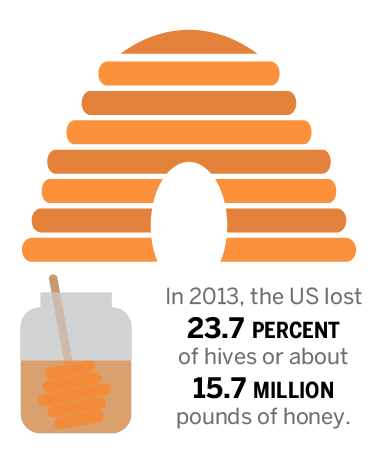Bees’ death linked to parasites, pesticides
October 18, 2015

Honeybees are beleaguered by a number of often lethal diseases, many of which do not have an obvious solution.
The most common of apian diseases is infestation by varroa mites, which are an obligate parasite to the honeybees. Two species of mites, Varroa destructor and Varroa jacobsoni, act like mosquitoes – they penetrate the bees’ exoskeletons to suck their hemolymph, the “blood” of invertebrates, leaving open wounds that make bees vulnerable to infection. In addition, varroa mites are themselves carriers of a virus that causes developmental wing deformities in honeybee larvae, crippling bee populations.
“Our only way to combat this is to lower the number of mites in a colony,” local beekeeper at Dominique Honeybees, Judy Casale, said. “We try to use organic approaches that will kill the mites without hurting the bees. And that’s the hard part – killing a bug on a bug without killing both bugs.”
There is no ready cure for varroa mites. While treatments do exist, they are not completely effective, and the remaining mites become selectively resistant to cures.
“The problem with mites is, we never completely get rid of them,” Dr. Hunt said. “In addition, when colonies collapse from [varroa mites], other bees rob the honey from the colony and pick up mites.”
While this problem is prolific, surprisingly few beekeepers take action against it. According to a 2015 “Varroa Summit” report by the United States Department of Agriculture’s Agricultural Research Service, 59 percent of beekeepers who responded to a national survey reported the presence of varroa mites, yet did not treat them.
Dr. Hunt has been working on a unique solution to help colonies resist infestation from mites in a sustainable way.
“At Purdue, we’re breeding for bees that groom mites off of themselves and bite mites,” Dr. Hunt said.
These “Indiana mite-biter” queens have been selectively bred to create bee colonies that instinctually remove mites.
“We started in 2007 and had an average of three percent chewed mites in our top breeding population. Now we’re up to about almost 50 percent,” Dr. Hunt said. “We also did a community beekeeper volunteer experiment, where we gave beekeepers queens from commercial queen breeders, or from Purdue stock. They didn’t know which was which. After over a year of this, 44 percent of the Purdue queens died compared to 78 percent of the commercial colonies.”

Efforts like Dr. Hunt’s may be employed to help mitigate the effects of varroa mites on commercial colonies in the near future.
Another common apian disease is a bacterial infection called foulbrood, which comes in American and European strains. Foulbrood infects bee larvae, killing them while still in development. Foulbrood continues to grow in the corpses of the larvae, creating millions of bacterial spores that spread the disease.
When worker bees clean up the hive and remove the dead larvae, they catch these spores, which contaminate the hive’s food supply. These spores are resistant to destruction, remain viable for up to 40 years and can only be effectively destroyed by burning the infected hive.
One potential factor in CCD that is only recently beginning to be investigated is the use of artificial pesticides containing neonicotinoids, which have been linked to bee deaths.
Neonicotinoids are water-soluble insecticides similar to nicotine, the active ingredient in tobacco. Because of neonicotinoids’ relatively long shelf life (decomposition takes around 3.8 years in the absence of sunlight), the chemical can accumulate in the environment and poison bees even without direct application. Hampering honeybees’ ability to detect nectar, navigate and remember feeding locations, neonicotinoids can severely reduce a colony’s ability to feed its workers and larvae.
Response to these studies has been mixed. In 2013, the European Union motioned to restrict the usage of these pesticides for three years. America has not written any legislature against pesticides, although some activists have called for action.
While the decline of honeybee populations continue, governmental authorities and scientists are working to combat it.
“It’s a struggle this year, and the drought has certainly affected things, and colony collapse has affected things,” Casale said. “But the one good thing is that it’s getting interest from the public and government groups to research.”